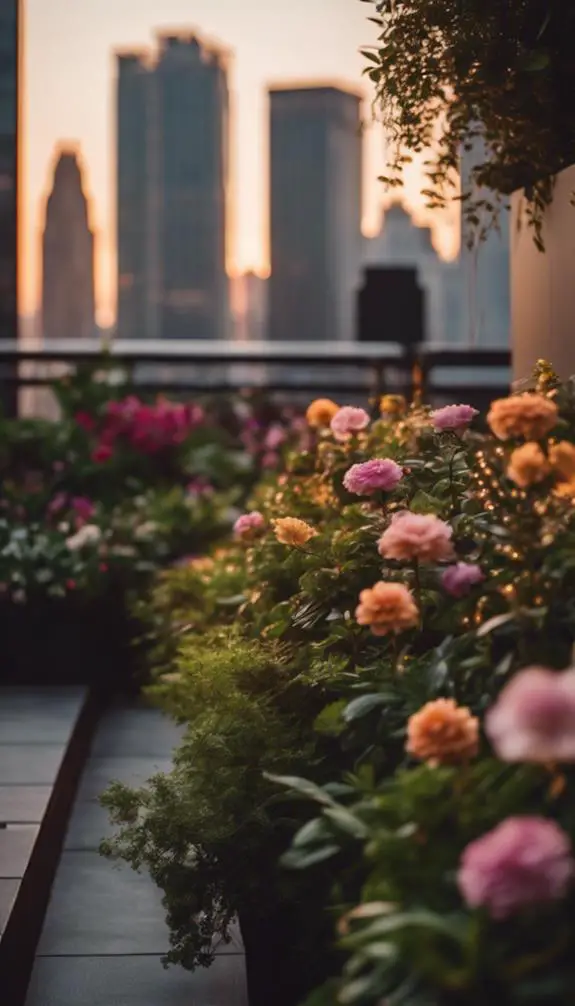As you envision your rooftop garden, you're likely imagining a serene escape from the hustle and bustle of daily life. But before you start selecting plants and picking out furniture, verifying your rooftop's capabilities is crucial. You'll need to ponder its weight-bearing capacity, guarantee proper drainage, and select materials that can withstand extreme temperatures. By doing so, you'll set the stage for a functional and visually stunning space that meets your unique needs. But that's just the beginning – with the right planning, your rooftop garden can become so much more than you ever thought possible.
Summary
- Assess the rooftop's weight-bearing capacity and structural integrity to ensure it can support the garden's weight and features.
- Select plants that thrive in the local climate zone, considering wind direction, sunlight exposure, and temperature fluctuations.
- Choose durable, eco-friendly materials for planters, furniture, and shade structures that can withstand extreme weather conditions.
- Incorporate space-saving designs and efficient layouts to create a functional oasis with pathways, seating areas, and ambient lighting.
- Consider themed elements, such as water features, vertical gardens, and wind-resistant plants, to create a unique and inviting atmosphere.
Assessing Rooftop Conditions
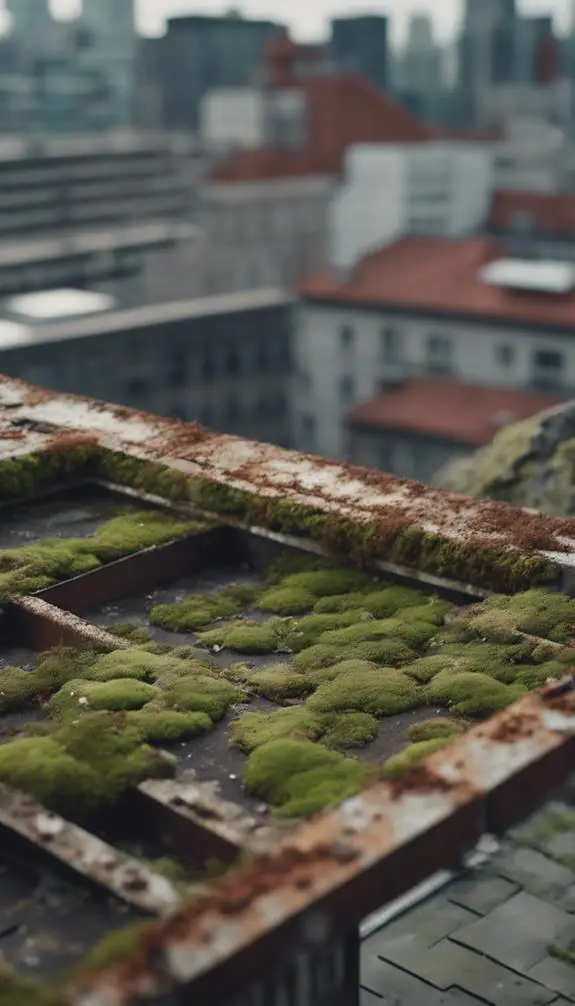
Your rooftop's structural integrity and existing conditions play a pivotal role in determining the feasibility and design of your rooftop garden.
You'll need to assess the weight-bearing capacity of your roof to guarantee it can support the weight of soil, plants, and any additional features like walkways or seating areas.
Rooftop accessibility is also essential, considering factors like stairway or elevator access, doorways, and any obstacles that might hinder movement.
Additionally, inspect your roof's surface for any cracks, damage, or signs of wear, as these could impact the garden's drainage and overall performance.
Choosing the Right Plants

When selecting plants for your rooftop garden, you'll need to ponder the specific climate zone you're in, as this will impact the types of plants that can thrive in your area.
You'll also want to check the plant hardiness ratings to guarantee the plants you choose can withstand the temperature fluctuations and extreme weather conditions often found on rooftops.
Climate Zone Considerations
Across the vast expanse of rooftop gardens, climate zones play a crucial role in determining the types of plants that will thrive.
You'll need to ponder the specific microclimate conditions on your rooftop, including factors like wind direction, sunlight exposure, and temperature fluctuations.
Conduct a microclimate analysis to identify the unique conditions on your rooftop and use climate mapping to determine which hardiness zone you're in.
This information will help you select plants that are well-suited to your rooftop's specific climate conditions.
By doing so, you'll guarantee your plants receive the right amount of moisture, sunlight, and nutrients to flourish.
With careful planning, you can create a thriving rooftop garden that's tailored to your local climate.
Plant Hardiness Ratings
Armed with knowledge of your rooftop's microclimate and hardiness zone, you're now ready to select plants that will thrive in your unique environment.
Plant hardiness ratings are vital in determining which plants can survive winter temperatures in your area. The USDA Plant Hardiness Zone Map divides North America into 11 zones, each representing a 10-degree Fahrenheit difference in winter temperatures.
By knowing your zone, you can choose plants that are tailored to your region's winter survival requirements. For instance, if you're in Zone 5, you'll want plants that can withstand temperatures as low as -20°F.
Research plant hardiness ratings to confirm your rooftop garden is filled with plants that will flourish, not flounder, in the face of winter.
Thermal Tolerance Levels
Dig into plant catalogs and online resources to uncover the thermal tolerance levels of your desired rooftop garden plants.
You'll want to know how they'll perform under intense heat, as heat stress can be devastating to your garden. Check the specific temperature ranges that your plants can tolerate, and consider the soil depth required to provide adequate insulation.
Some plants might thrive in shallow soil with excellent drainage, while others need deeper roots to access cooler temperatures. By understanding thermal tolerance levels, you can create a rooftop oasis that's resilient to scorching summers and chilly winters.
Selecting Durable Materials
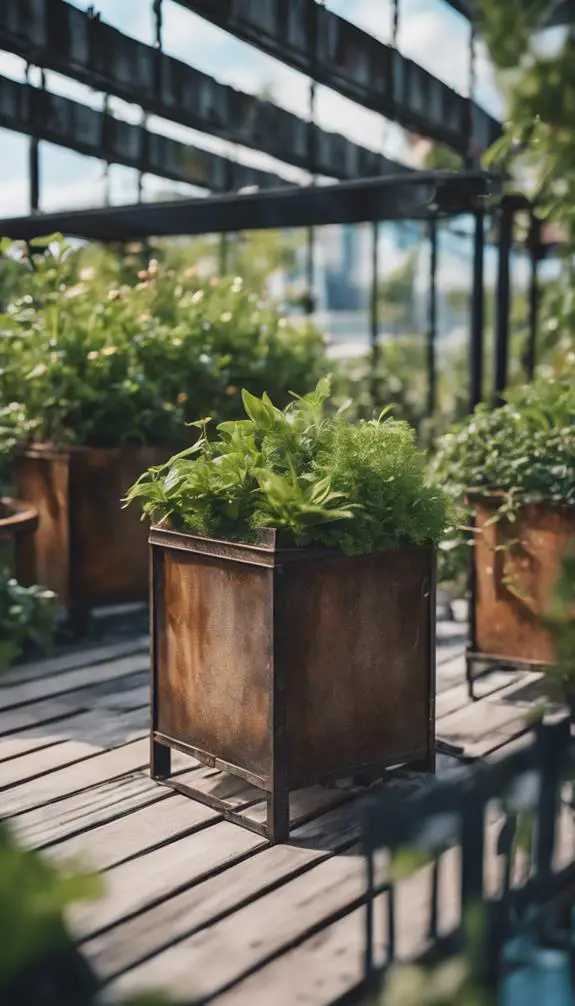
Choosing the right materials for your rooftop garden is essential, as they'll be exposed to harsh weather conditions and heavy use.
You'll want to select materials that can withstand extreme temperatures, intense sunlight, and heavy rainfall. When considering material selection, think about durability, sustainability, and low maintenance.
Cost considerations are also pivotal, as rooftop gardens can be expensive to install and maintain. Look for materials that offer a good balance of quality and affordability.
For example, recycled plastic planters and composite decking can provide a durable and eco-friendly solution. Additionally, consider using weather-resistant fabrics, such as Sunbrella, for your outdoor furniture and shade structures.
Creating a Themed Oasis
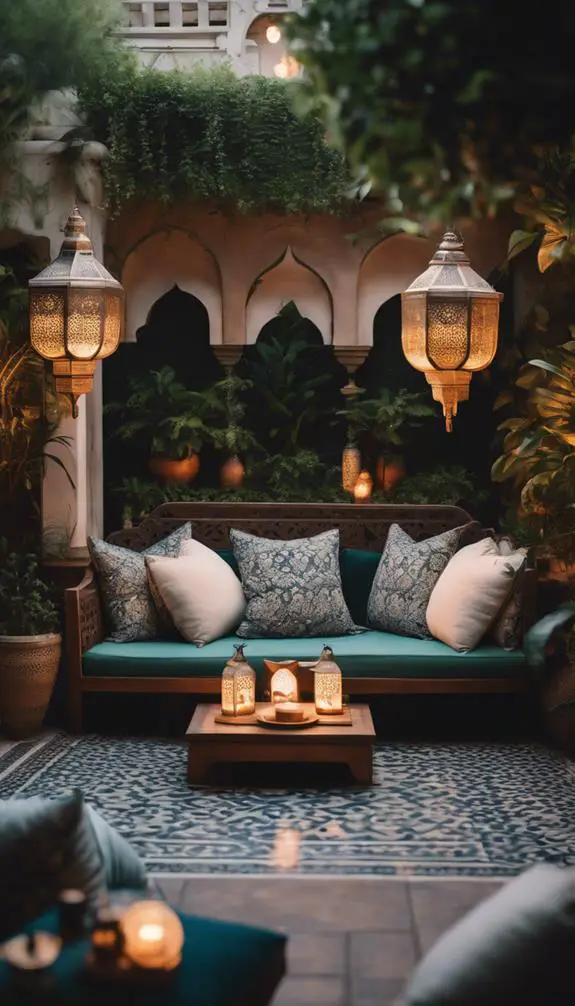
As you begin designing your rooftop garden, consider what kind of atmosphere you want to create, and let that guide your decisions on layout, plant selection, and decorative elements.
For a Desert Oasis, incorporate drought-tolerant plants like succulents and cacti, and use natural stone or gravel as a ground cover. Add warm-toned furniture and decorative accents like terracotta pots to evoke a sense of arid tranquility.
Alternatively, create a Whimsy Wonderland by incorporating playful elements like colorful planters, twinkling string lights, and whimsical sculptures. Choose plants with bold, bright blooms and varied textures to add visual interest. Consider adding a statement piece, like a oversized flower-shaped planter or a mosaic-tiled bench, to tie the space together.
Incorporating Water Features

As you design your rooftop garden, you'll want to ponder incorporating water features that create a sense of serenity and visual interest.
You can install a small pond, complete with aquatic plants and a self-sustaining ecosystem, or opt for a fountain that provides a soothing soundtrack and dynamic visual display.
When selecting a fountain design, choose from options like wall-mounted, freestanding, or tabletop styles that fit your space and aesthetic.
Small Pond Installations
Your rooftop garden's tranquility is elevated by incorporating a small pond installation, which not only adds visual appeal but also creates a soothing atmosphere.
To maximize pond aesthetics, consider the shape, size, and material of the pond. A rectangular or square pond can provide a modern, sleek look, while a natural stone or concrete pond can blend seamlessly with the surrounding landscape.
Water reflections can also be manipulated to enhance the ambiance. By strategically placing surrounding plants or architectural elements, you can create a sense of calm and serenity.
For example, floating plants or water lilies can add a touch of elegance, while a nearby seating area can invite relaxation.
Fountain Design Options
Fountains can become a striking centerpiece in your rooftop garden, introducing a dynamic visual element that captivates the senses.
You can choose from various fountain styles, such as wall-mounted, pedestal, or tabletop designs, to complement your garden's aesthetic.
Consider the water sounds you want to create, from gentle trickles to dramatic cascades, to create a soothing ambiance.
To add visual interest, incorporate LED lighting or natural stone surrounds.
For a more modern look, opt for sleek, minimalist designs or geometric patterns.
Whatever style you choose, a well-designed fountain will create a mesmerizing focal point, drawing visitors' eyes and calming their minds.
Designing for Wind Resistance
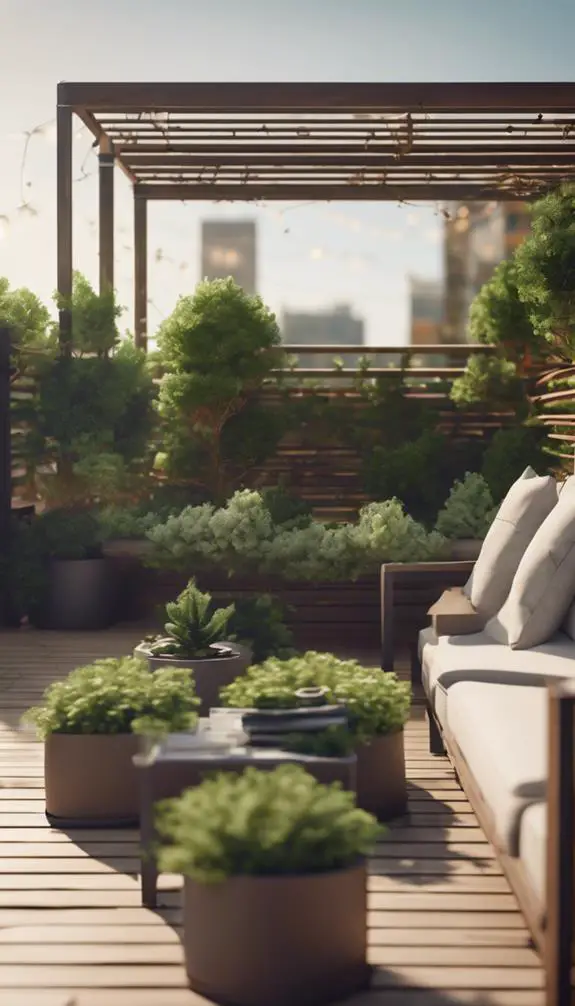
Beyond the rooftop's edge, winds howl and whip, exerting tremendous force on your meticulously planned garden.
To safeguard your rooftop oasis withstands these gusts, you'll need to weigh wind patterns and structural reinforcement. Study the wind direction and speed in your area to determine the most vulnerable spots.
Then, select plants with low centers of gravity and a deep root system to resist uprooting. For added security, anchor planters and garden features with sturdy fasteners and weigh using windbreaks like trellises or screens.
Building a Green Roof

You'll need to prepare your roof for a green roof installation by ensuring it's structurally sound, waterproof, and clear of debris.
This involves inspecting the roof's surface for cracks, blisters, and damaged flashing, and making any necessary repairs.
Once your roof is ready, you can begin installing the green roof system, which typically consists of a waterproofing membrane, drainage layer, and growing medium.
Roof Preparation Essentials
About 70% of a rooftop garden's success hinges on proper roof preparation, which is why it's crucial to get this pivotal step right.
You'll need to conduct thorough roof membrane checks to verify it's watertight and can withstand the added weight of your green roof. Look for cracks, blisters, or punctures, and repair or replace the membrane as needed.
Next, perform structural assessments to determine if your roof can support the weight of the garden, including the soil, plants, and irrigation system. This includes evaluating the roof's load-bearing capacity, beam strength, and foundation stability.
Green Roof Installation
With your roof membrane checked and structural assessments complete, it's time to transform your rooftop into a lush oasis.
You'll start by applying a waterproofing layer, followed by a drainage system to prevent waterlogged soil.
Next, you'll install a layer of insulation to regulate temperatures and reduce energy costs.
Now it's time to choose your roofing material options, such as EPDM, PVC, or bitumen.
Consider the green roof benefits, like increased energy efficiency, improved air quality, and habitats for local wildlife.
Adding Ambient Lighting

As the sun dips below the horizon, your rooftop garden transforms into a serene oasis, perfect for relaxation and entertainment.
To enhance this ambiance, you'll want to incorporate ambient lighting that creates a Soft Glow, reminiscent of a moonlit night. Strategically place pathway lights or lanterns to create a Moonlight Accent, highlighting the garden's unique features.
Use energy-efficient LED lights with a warm color temperature (2700K-3000K) to produce a cozy atmosphere. Consider installing dimmers or smart lighting systems to adjust the lighting levels according to your mood or the time of day.
Maximizing Space Efficiency

How do you make the most of your rooftop garden's limited space?
By incorporating space savers and efficient layouts, you can create a functional and beautiful oasis.
Consider a symmetrical layout to create a sense of harmony, and use rectangular planters to maximize corner spaces.
Install a trellis or arbor to provide support for climbing plants, freeing up floor space.
Utilize wall-mounted planters and shelves to add depth and visual interest.
Don't forget to leave space for pathways and seating areas, ensuring easy navigation and relaxation.
With careful planning, you can turn your rooftop into a thriving garden that's both functional and aesthetically pleasing.
Incorporating Vertical Gardens

Your rooftop garden's walls can become a lush tapestry of greenery with the strategic incorporation of vertical gardens.
By installing vertical walls, you can increase your garden's surface area, providing more space for plants to thrive.
Living screens, a type of vertical garden, can be attached to railings or walls, adding an extra layer of greenery to your rooftop oasis.
These screens can be customized to fit your space, with options for trellises, planters, or hydroponic systems.
With careful planning, you can create a stunning display of foliage that not only enhances your garden's aesthetic but also provides insulation, reduces wind, and creates a sense of seclusion.
Rooftop Furniture Essentials
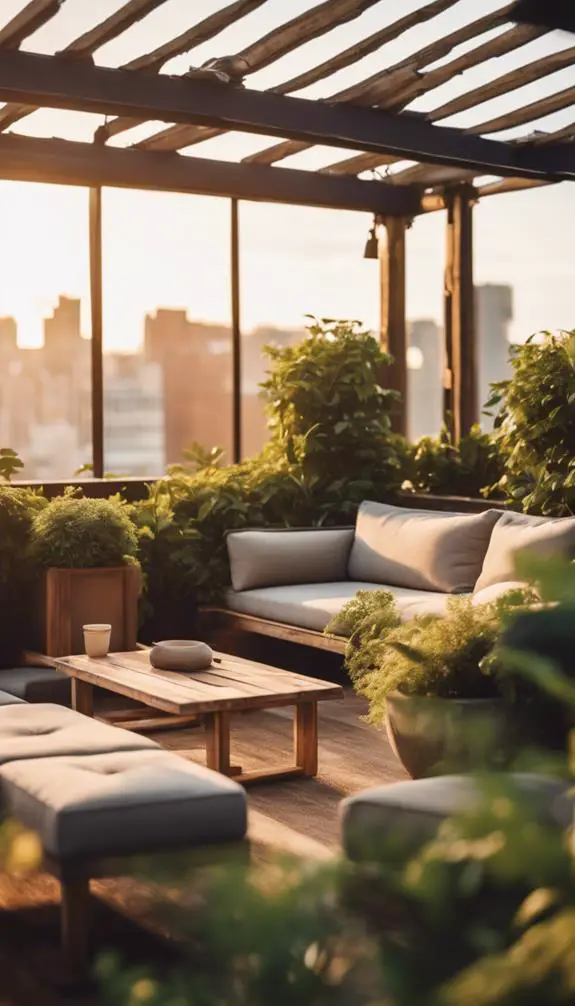
Beyond the lush greenery, rooftop furniture essentials transform your outdoor space into a functional oasis.
You'll want to prioritize weather-resistant, low-maintenance pieces that complement your rooftop's unique features. Consider sleek, modular seating for rooftop lounging, such as a sectional sofa with built-in planters or a chic daybed with a retractable canopy.
Add ambiance with outdoor decor like string lights, lanterns, or a statement fire pit. Don't forget functional accents like outdoor rugs, side tables, and planters that double as storage.
Maintaining Rooftop Gardens

Establish a routine to inspect your rooftop garden regularly, ideally during early morning or late afternoon when the sun's intensity is gentler, allowing you to spot potential issues before they escalate.
Check for signs of wear and tear on planters, trellises, and furniture, and perform repairs or replacements as needed. Verify proper drainage and irrigation systems are functioning correctly to prevent waterlogged soil and erosion.
Inspect railings and guardrails for stability and secureness, prioritizing garden safety above all. Regular rooftop maintenance will prevent minor issues from becoming major problems, guaranteeing your rooftop oasis remains a tranquil retreat.
Dealing With Rooftop Challenges

As you navigate the unique terrain of rooftop gardening, you'll inevitably face challenges that test your resolve and creativity.
To overcome these obstacles, you must prioritize Rooftop Preparation, ensuring your surface is structurally sound and able to support the weight of your garden.
Assess your roof's Structural Integrity by inspecting for cracks, sagging, or signs of wear.
Consider hiring a professional to evaluate your roof's condition and provide guidance on necessary repairs or reinforcements.
FAQs
Can I Have a Rooftop Garden on a Sloping Roof?
You can adapt a sloping roof for a garden by incorporating a sloping design, which may require roof restructuring to guarantee stability and drainage, but with careful planning, you'll be rewarded with a unique, visually stunning space.
How Do I Prevent Pests From Entering My Rooftop Garden?
To prevent unwanted visitors, you'll implement integrated pest control methods, such as fine-mesh screens, copper tape barriers, and organic repellents, within your garden enclosures, ensuring a secure, thriving oasis that's both visually stunning and pest-free.
Are There Any Rooftop Garden Ideas for Small Budgets?
On a tight budget, you can create a stunning outdoor space by opting for budget-friendly DIY planters, repurposing items like wooden crates or old boots, and incorporating space-saving designs that maximize vertical growth, making the most of your compact area.
Can I Grow Vegetables in My Rooftop Garden?
You can maximize rooftop yields through vertical farming, where you'll train vining veggies like peas, cucumbers, or tomatoes to climb up trellises or walls, making the most of your space and increasing your harvest.
Do Rooftop Gardens Increase Property Value?
You boost your property's appeal and valuation through clever urban landscaping, as rooftop appraisals now factor in eco-friendly features, increasing your home's worth and making it a standout in the market.
Conclusion
Transform your rooftop into a serene oasis by considering every detail. You've assessed the weight-bearing capacity, chosen climate-hardy plants, and selected durable materials. Your themed space now features ambient lighting, vertical gardens, and water features. With wind-resistant design and essential furniture, your rooftop retreat is complete. Regular maintenance will guarantee your haven remains tranquil. By following these rooftop garden ideas, you've successfully created a functional and visually appealing escape from the hustle and bustle below.



